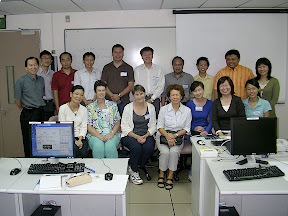Here are some of the photos...
Thursday, December 6, 2007
Ascilite Workshop 2007 (2 Dec 2007)
On 2 Dec 2007, Dr Quek, Timothy Cheng, Sok Ngin and myself conducted a workshop on concept mapping...
Here are some of the photos...


Here are some of the photos...
Saturday, November 17, 2007
Wednesday, November 14, 2007
Tuesday, November 6, 2007
iN2015 (Video from IDA, Singapore)
Have you watched this?
The Intelligent Nation 2015? A vision for Singapore...
The Intelligent Nation 2015? A vision for Singapore...
Tuesday, October 30, 2007
Monday, August 6, 2007
General Properties of Waves
Just completed Thermal Physics with my pupils...
Starting with Waves Properties now...
Let's watch some video clips from youtube...
What are waves?
A wave is a disturbance that propagates through space or spacetime, transferring energy.
There are two types of waves and they are known as:
1) Transverse waves
For transverse waves the displacement of the medium is perpendicular to the direction of propagation of the wave. Examples include electromagnetic waves (radio wave, microwave, light, etc), water wave, etc.
Extracted from the BBC GSCE Website url: here

2) Longitudinal Waves
In a longitudinal wave the particle displacement is parallel to the direction of wave propagation. Sound is a form of longitudinal wave.
Extracted from the BBC GSCE Website url: here

Some properties of waves include:
1) Wavelength
The distance between two consecutive points on the wave that are in phase. E.g. Distance between two consecutive wave troughs or wave crests.
Its SI units is metre (m) and the symbol is a greek letter "lamda"
2) Frequency
Wave frequency, f , is known as the number of complete wave cycles in one second. It is measured in hertz (Hz).
Wave period, T , is the reciprocal of frequency. It is measured in seconds (s).
Period = 1/frequency
3) Wave Speed
Wave Speed, v = wavelength x frequency
Wave speed, v = wavelength / Period

Some other interesting websites on Waves:
Crocodile Clip
Starting with Waves Properties now...
Let's watch some video clips from youtube...
What are waves?
A wave is a disturbance that propagates through space or spacetime, transferring energy.
There are two types of waves and they are known as:
1) Transverse waves
For transverse waves the displacement of the medium is perpendicular to the direction of propagation of the wave. Examples include electromagnetic waves (radio wave, microwave, light, etc), water wave, etc.
Extracted from the BBC GSCE Website url: here

2) Longitudinal Waves
In a longitudinal wave the particle displacement is parallel to the direction of wave propagation. Sound is a form of longitudinal wave.
Extracted from the BBC GSCE Website url: here

Some properties of waves include:
1) Wavelength
The distance between two consecutive points on the wave that are in phase. E.g. Distance between two consecutive wave troughs or wave crests.
Its SI units is metre (m) and the symbol is a greek letter "lamda"
2) Frequency
Wave frequency, f , is known as the number of complete wave cycles in one second. It is measured in hertz (Hz).
Wave period, T , is the reciprocal of frequency. It is measured in seconds (s).
Period = 1/frequency
3) Wave Speed
Wave Speed, v = wavelength x frequency
Wave speed, v = wavelength / Period

Some other interesting websites on Waves:
Crocodile Clip
Subscribe to:
Comments (Atom)


